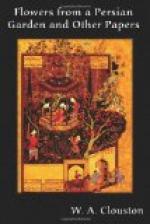And, in my dreme, methocht come throw
the schaw[137]
The fairest man that ever befoir I saw.
His gowne wes of ane claith als quhyte
as milk,
His chymeris[138]
wes of chambelote purpour broun;
His hude[139] of scarlet, bordourit[140]
weill with silk,
On hekellit-wyis,[141]
untill his girdill doun;
His bonat round,
and of the auld fassoun,[142]
His beird was quhyte, his ene was greit
and gray,
With lokker[143] hair, quilk ouer his
schulderis lay.
Ane roll of paper in his hand he bair,
Ane swannis pen stikkand[144]
under his eir,
Ane inkhorne, with ane prettie gilt pennair,[145]
Ane bag of silk, all at his
belt can beir:
Thus was he gudelie graithit[146]
in his geir.
Of stature large, and with ane feirfull[147]
face;
Evin quhair I lay, he came ane sturdie
pace.
[135] Mr. Jacobs was obliged to omit the
Life of Esop in his
reprint
of Caxton’s text of the Fables, as it would have
unduly
increased the bulk of his second volume. But
those
interested in the genealogy of popular tales and
fables
will be glad to have Mr. Jacobs’ all but
exhaustive
account of the so-called Esopic fables,
together
with his excellent synopsis of parallels, in
preference
to the monkish collection of spurious
anecdotes
of the fabulist, of which the most noteworthy
are
given in the present paper.




